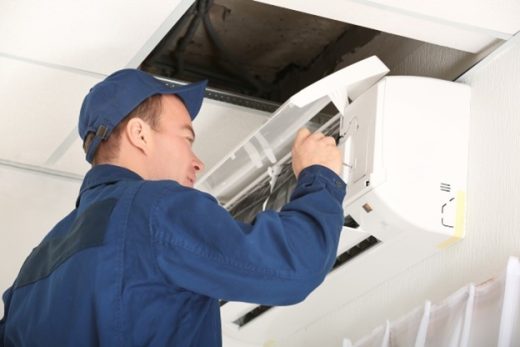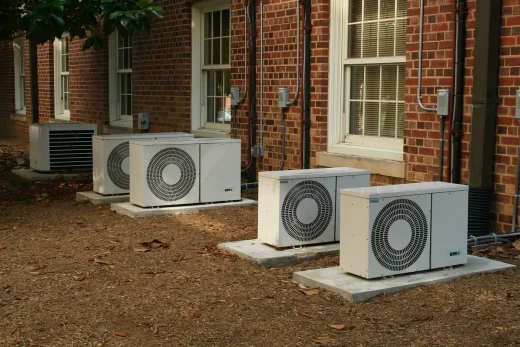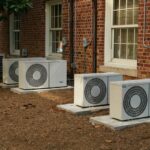Challenges and solutions in retrofitting historic buildings with modern AC systems, architecture
Retrofitting historic buildings with modern AC systems guide
5 February 2025
Historic buildings are an integral part of our architectural heritage, preserving culture, craftsmanship, and history. However, as these structures age, they often lack the modern conveniences that today’s occupants expect—chief among them, an efficient air conditioning system.
Retrofitting historic buildings with modern AC installation presents a unique set of challenges, requiring a careful balance between comfort, efficiency, and preservation. In this article, we will explore the key obstacles involved in installing air conditioning in historic properties and the innovative solutions that architects, engineers, and HVAC professionals are employing to overcome them.
Challenges of Retrofitting Historic Buildings with AC Systems
- Structural Limitations and Space Constraints
Many historic buildings were not designed to accommodate ductwork or large HVAC equipment. The walls, ceilings, and floors in these structures may lack the necessary space for conventional air conditioning systems. Additionally, load-bearing walls and structural integrity concerns can limit the placement of new systems, making AC installation more complex than in modern buildings.
- Preservation Regulations and Compliance
Historic buildings are often subject to strict preservation laws and guidelines. These regulations aim to maintain the original architectural character and prevent modifications that could compromise historical integrity. HVAC installation must comply with local, state, and national historic preservation standards, limiting the extent of alterations allowed.
- Aesthetic and Architectural Concerns
The visual impact of modern air conditioning systems can disrupt the historical authenticity of a building. Large ducts, vents, and external condenser units may clash with the original design, leading to resistance from preservation authorities and building owners. Maintaining aesthetics while integrating modern AC installation requires innovative solutions.
- Electrical and Mechanical Constraints
Older buildings often have outdated electrical and mechanical systems that may not support the power requirements of modern HVAC units. Upgrading electrical infrastructure can be costly and invasive, requiring careful planning to minimize disruption to the historic fabric of the building.
- Insulation and Energy Efficiency Issues
Many historic buildings were not constructed with energy efficiency in mind. Poor insulation, drafty windows, and outdated materials can make cooling inefficient, leading to increased energy consumption and higher operational costs. Finding ways to improve energy efficiency while maintaining the building’s historical integrity is a crucial challenge.
Solutions for Retrofitting AC Systems in Historic Buildings
- Ductless Mini-Split Systems
One of the most effective solutions for retrofitting historic buildings is the use of ductless mini-split systems. These systems require minimal structural modifications, as they do not rely on extensive ductwork. Instead, they consist of small indoor units connected to an outdoor condenser via a thin refrigerant line. This approach allows for efficient cooling while preserving the architectural integrity of the building.
- High-Velocity HVAC Systems
High-velocity HVAC systems use smaller, flexible ducts that can be installed through existing wall cavities, attics, or under floors with minimal disruption. These systems are ideal for historic buildings because they provide powerful cooling while remaining discreet. The small-diameter tubing reduces the need for extensive demolition, preserving original structures.
- Geothermal Cooling Solutions
For buildings with large surrounding land areas, geothermal cooling offers a sustainable solution. This system leverages underground temperature stability to provide energy-efficient cooling. While the upfront installation cost can be high, geothermal systems significantly reduce long-term energy expenses and minimize the need for visible external HVAC units.
- Window and Wall-Mounted Units with Custom Enclosures
When central air systems are not feasible, strategically placed window or wall-mounted units can provide localized cooling. Custom enclosures designed to blend with the building’s architecture can help minimize the visual impact. Modern window AC units also offer energy-efficient options with minimal disruption.
- Smart Climate Control and Zoning
Installing smart thermostats and zoning systems allows for precise temperature control, optimizing cooling efficiency while reducing strain on historic electrical systems. By cooling only occupied areas, these solutions improve comfort without overloading the building’s power capacity.
- Upgrading Insulation and Ventilation
Enhancing insulation without compromising historical integrity can improve the effectiveness of AC installation. Solutions such as interior storm windows, thermal curtains, and eco-friendly insulation materials help regulate indoor temperatures without altering the building’s external appearance.
Case Study: Successful AC Installation in a Historic Building
A prime example of effective HVAC retrofitting is the installation of a ductless mini-split system in a 19th-century townhouse. The project team faced challenges related to structural limitations and preservation laws.
By utilizing concealed refrigerant lines and placing indoor units in less obtrusive areas, they successfully integrated modern air conditioning without compromising the building’s historical charm. The result was an energy-efficient, aesthetically pleasing solution that provided enhanced comfort for occupants.
Buillding Air Conditioning System Conclusion
Retrofitting historic buildings with modern AC installation is a delicate process that requires balancing comfort, efficiency, and preservation. By leveraging innovative HVAC technologies such as ductless mini-splits, high-velocity systems, geothermal cooling, and smart climate control, professionals can provide effective cooling solutions while maintaining the architectural integrity of these treasured structures. With careful planning and creative problem-solving, historic buildings can remain comfortable and functional without sacrificing their historical significance.
Comments on this guide to Challenges and Solutions in Retrofitting Historic Buildings with Modern AC Systems article are welcome.
HVAC – Air Conditioners
Air Conditioners Posts
Why Rely On Professionals For Air Conditioning, Heating, HVAC

HVAC Systems in Modern Architecture
5 great advice from top rated HVAC contractor
Buildings
Residential Architecture Articles
Comments / photos for the Challenges and Solutions in Retrofitting Historic Buildings with Modern AC Systems page welcome.






